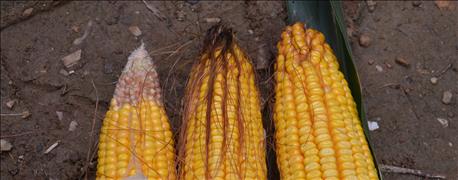
The three ears in the picture aren’t from different parts of the same field. In fact, they were pulled from three consecutive stalks, shucked and laid down for the photo. There is no trick photography. What you see is what you get.
These three very different ears would result in very different yield estimates, depending upon which one is actually representative of the field. As it turns out, the two larger ears are more representative in this case. This field will likely yield fairly well this fall.
Corn Illustrated 8/29: Will you see ear rots in corn this year?

1 OUT OF 3: When you find two good ears side by side followed by an ear with aborted kernels at the tip, it might be worth figuring out why so you can make changes for next year.
So where did the shorter ear with tip dieback come from? Here are four possible explanations. Dave Nanda, a crops consultant based in Indianapolis, reviewed these explanations.
1. The microclimate around the stalk producing the smaller ear was different.
Perhaps the smaller ear grew on a smaller stalk that had a closer neighbor than the stalks that produced the two longer, better-filled ears. Competition early in the season can definitely affect decisions plants make about ear size throughout the season, Nanda says. If this plant was too close to another plant, was it because of poor seed singulation at planting?
2. Later emergence set back the plant with the smaller ear.
If the planter setup didn’t result in uniform seed placement, it might have led to uneven plant emergence. Plants that emerge late often struggle. In fact, Nanda says if they emerge too late, they can act like a weed. This plant produced an ear, but if the plant was running behind its neighbors when key decisions were made, it may have decided to produce a smaller ear than neighboring plants.
3. A difference in pollination time affected kernel development.
If the plant producing the smaller ear was delayed in emergence, or for whatever reason delayed in growth, it may have pollinated at a different time than its neighbors. A different pollination time could have affected what happened to the kernels at the tip of the ear. Perhaps there wasn’t as much pollen left and the tip didn’t pollinate correctly. Or perhaps it was hotter or dryer when the smaller ear pollinated, and the kernels formed but then aborted.
Corn Illustrated 8/22: Should you use foliar fungicides in corn?
4. The plant sensed the opportunity to produce fewer viable kernels.
If any one of the scenarios above led to the smaller ear, it could have set the plant up to make the decision to abort tip kernels to protect other kernels, Nanda says. Remember, he notes, the plant thinks it is making babies, and its overriding goal is to produce as many viable "seeds" as possible so it can reproduce. Something signaled the plant that it needed to cut back on the number of kernels and save the ones it could produce properly, Nanda concludes.
About the Author(s)
You May Also Like




